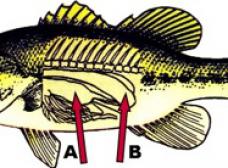Barotrauma and the art of ‘Fizzing’ a Bass
Summer patterns are typically deep-water patterns, with many anglers catching bass from depths of 20-foot or more. Unfortunately, many fish will die because most recreational anglers do not know how to take care of fish that have been brought up from the depths too quickly.
What is barotrauma?
When you catch a fish from water any deeper than 30-foot (9m) the swim bladder will inflate because the water pressure on the bladder decreases as you bring the fish up to the surface. Sometimes the bladder will swell up so much that it will actually protrude from the mouth.
With this added buoyancy, an exhausted fish may experience great difficulty keeping itself upright and will not be able to swim back down to the depths it was caught from. This is called Barotrauma and clear symptoms show a body that looks swollen, eyes that look as though they are popping out and, upon release, you see the fish floundering on the surface.
Treating Barotrauma
Bring the fish in quickly to avoid over-tiring it and, if the bladder is not protruding from the mouth, release it immediately. Drop the fish nose-first to help it gain momentum to swim down to the depths, where the increasing water pressure will compress the swim bladder again. If you do not release the fish immediately gas bubbles will accumulate in the blood, which will lessen the chances of survival. If the fish is not strong enough to overcome the buoyancy it will float back to the surface again. This is the time to apply emergency procedures, which starts with ‘fizzing’ the bass - the act of removing air from the swim bladder. (See illustration).
‘Fizzing’ Procedure
Remove a scale and insert an 18- to 20-gauge hypodermic needle 3 to
scale rows below the lateral line and in line with the notch between the dorsal fins and the vent.
Listen for escaping gas. You may have to push on the belly to help force out some of the gas.
If the stomach does not pull back from the mouth you may have to push it back gently with a blunt object.
When you have released a fish that has been de-gassed keep an eye open to see that it does not float back up. If it does re-surface repeat the de-gassing procedure. If it still fails to swim down unaided it may be beyond help and destined for the dining table.
Fish caught in water deeper than 50-foot may suffer more serious damage such as ruptured blood vessels and gas bubbles in vital organs. When you see blood-spots on the body or fins and bugged-out eyes the fish will very likely die and there is no use trying to release it.
By taking proper care of our fish we can take pride in helping to maintain the future of our sport, be examples to others as to how it should be done and at the same time be held in high regard as top-notch anglers.














0 Comments